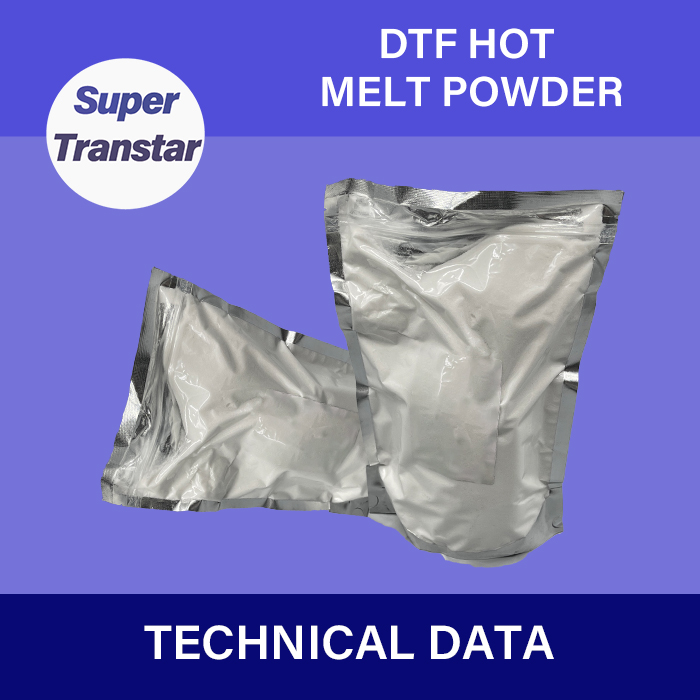- 29
- Apr
DTF Powder Introduction & MSDS
|
PDF Download
Material Safety Data Sheet
(MSDS)
Section 1 – Chemical Product and Company Identification
Product Name: Copolyester hot melt adhesive
Section 2 – Hazards Identification
Fatalness grade: Unclassified
Invasion route: /
Health hazards: No known significant effects or critical hazards
Environment hazards: No known significant effects or critical hazards
Burn & burst danger: The sample can ignited.
Section 3 –Composition/Information on Ingredient
Pure
Admixture ■
Composition:
| Chemical Name | Composition(in%
by weight) |
CAS No. | EC No. |
| copolyester | 98 | 25191-04-2 | — |
| antioxidant | 1 | 26741-53-7 | 247-952-5 |
| water | 1 | 7732-18-5 | 231-791-2 |
Section 4 – First Aid Measures
Skin touch: Remove contaminated clothes and rinse the skin with plenty of water.
Eyes touch: Lifting the upper and lower eyelids, flush the eyes with plenty of water or saline water. Get medical aid.
Inhalation: Remove from exposure and move to fresh air immediately. Keep the respiratory tract smooth. Use oxygen if available. Get medical aid.
Ingestion: Drink sufficient hot water and induce vomiting. Get medical aid.
Section 5 – Fire Fighting Measures Danger
Characteristic: The sample can ignited.
Hazardous combustion products: Nitrogen﹑ oxides﹑Carbon monoxide﹑Carbon dioxide
Fire-Fighting method & media: use extinguish ant such as water, chemical dry powder, carbon dioxide dry power, bubble to put out the fire.
Section 6 –Accidental Release Measures
Emergency treatment: It is suggested that the staff wear dust respirator and dress in work clothes. Shut off the divulgence source as soon as possible. Prevent the spillage flowing into restrictive space like the sewer and the drainage channel. Small amount of divulgence: clean off. Massive divulgence: recycle or transport to waste treatment place for handling.
Section 7 – Handling and Storage
Handling:. Supply with sufficient partial air exhaust. The operating staff must have received special training and abide by the operating regulations. It is advised that the staff wear respirator, wear work clothes, and wear gloves. Keep away from the fire source, heat source, no smoking in the workplace. Avoid producing dust. Use explosion-proof type ventilation system and device. Avoid contacting with oxidizer and strong acid. Equip with relevant types and quantities of extinguishment instruments and device for divulgence handling. Empty the container which may include harmful material
Storage: Stored in a cool, ventilation of the treasury.Away from fire, heat source.With the oxidant and acid stored separately, avoid mixing reservoir.Equipped with the appropriate variety and quantity of fire equipment.Storage areas should be equipped with emergency treatment equipment for leakage and suitable housing materials.
Section 8 – Exposure Controls, Personal Protection
Maximum admissible concentration: No standard yet.
Monitoring Method: /
Engineering Control: Not applicable
Respiratory Protection: Wear self-inhalation filter type dust respirator if the dust density exceed in the air.
Eyes Protection: Generally do not need special protection.
Body Protection: Generally do not need special protection.
Hands Protection: Generally do not need special protection.
Other Protections: No smoking, dining and drinking water in the workplace. Keep good habit of hygiene
Section 9 – Physical and Chemical Properties
Appearance: Powder
Color: White (colour)
Odor: No smell
Density:/
Boiling Point: No data.
Melting Point: /
Flashpoint:No data
Vapour pressure:No data.
Solubility in water:No data
Partition coefficient (n-octanol / water): No data.
Viscosity: Not applicable
PH Value: No data
Permission of solvent inhalation: No data.
Solubility: Insoluble in water
Ignition temperature:/
Section 10 – Stability and Reactivity
Stability: Stable under normal temperature and pressure.
Distribution of Ban: Strong oxidizer, strong acid.
Conditions to Avoid: Not applicable.
Hazardous Polymerization: No data
Hazardous Decomposition Products: Under normal conditions of storage and use
hazardous decomposition products should not be produced.
Section 11 – Toxicological Information
Acute Toxicity: No data.
Sub-acute and Chronic Toxicity: No data.
Irritation: No data.
Sensitization: No data.
Mutagenicity: No data.
Carcinogenicity: No data.
Others: /
Section 12 – Ecological Information
Eco-toxicity: No known significant effects or critical hazards.
Biodegradable: No applicable.
Non-biodegradable: No applicable.
Bioconcentration or biological accumulation: No applicable.
Other harmful effects: No known significant effects or critical hazards.
Section 13 – Disposal Considerations
Nature of waste: /
Waste disposal methods: /
Attention abandoned: It can be incinerated.
Section 14 – Transport Information
Number of dangerous goods: No applicable.
UN Number: No data.
Packaging Mark: No data.
Packaging Method: No data.
Transport Attentions: Examine whether the package of the containers are integrate and tighten closed before transport. No divulgence, no collapse, no precipitation or no damage during the course of transportation. Don’t put the goods together with oxidizer, acid and so on. The transport vehicle and ship must be cleaned and sterilized otherwise it is not allowed to assemble articles. During transport, the vehicle should prevent exposure, rain and high temperature. For stopovers, the vehicle should be away from fire and heat sources. Don’t use device and tools which easily produce spark for loading. When transported by sea, the assemble place should keep away from bedroom and kitchen, and isolated from the engine room, power and source. Under the condition of Road Transportation, the driver should drive in accordance with regulated route, don’t stop over in the residential area and congested area. No slipping up in rail road. According to the IMDG Code (inc Amdt 34-08) 2016 Edition, The sample is not regulated for transport of dangerous goods.
Section 15 – Regulatory Information
Regulatory Information:
ISO 11014-2009 Safety data sheet for chemical products – Content and order of sections.
Regulation (EC) No.1272/2008 Classification, Labeling and Packaging of Substances and Mixtures.
The International Maritime Dangerous Goods (IMDG) Code.
Section 16 – Additional Information
The above information is based on the data of which we are aware and is believed to be correct as of the data hereof. Since this information may be applied under conditions beyond our control and with which may be unfamiliar and since data made available subsequent to the data hereof may suggest modifications of the information, we do not assume any responsibility for the results of its use. This information is furnished upon condition that the person receiving it shall make his own determination of the suitability of the material for his particular purpose.

